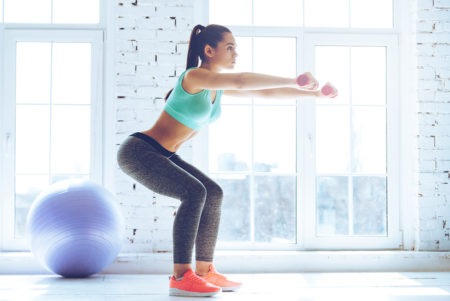 You can avoid surgery by doing squats, using body-weight exercise to strengthen knees. After more years than I would like to admit, my knees suffer from osteoarthritis, when the protective cartilage on the ends of your bones wears down over time. Trust me; I am not alone with this niggling, often painful malady. There are millions of men and women suffering the same condition (seniors or not!).
You can avoid surgery by doing squats, using body-weight exercise to strengthen knees. After more years than I would like to admit, my knees suffer from osteoarthritis, when the protective cartilage on the ends of your bones wears down over time. Trust me; I am not alone with this niggling, often painful malady. There are millions of men and women suffering the same condition (seniors or not!).
Other than surgery, there is no way to reverse osteoarthritis. Even surgery doesn’t cure it; there isn’t yet anyway to replace cartilage, although they are working on that. Mostly, doctors recommend knee replacement surgery when it becomes too painful.
Alternatively, however, there is something you can do to delay the knife. You can choose to strengthen the muscles, tendons and ligaments surrounding your knees through a slow buildup of leg exercises. The easiest way to do this is using your own body-weight.
Body-Weight Exercise
A good body-weight exercise for knees is to start weekly sessions of semi or half-squats which will progressively build the quadriceps, hamstrings, and calves. Even half-squats represent a significant workout.
In fact, squats can trigger the release of testosterone and human growth hormone in your body, which are important for growing muscle lost from years of inactivity. Squats will also help to improve muscle mass when you train other areas of your body aside from your legs.
A word of caution: Most people over the age of 50 have not used their legs for much more than transportation for a number of years and for this reason squats, even half-squats, can be traumatic in the beginning. Like any new exercise you must start slowly, only attempting a few repetitions on day one. And even with a light workout regimen, you will experience some soreness the following days.
Strong legs are crucial for staying mobile as we age, and squats are extraordinary for increasing leg strength. They also work out the core by stabilizing all your lower body muscles, helping you to maintain balance, which helps prevent falls – the #1 way to prevent bone fractures.
Easy does it: After a few weeks you can increase your repetitions, say from one set of six, to two or even three sets of ten repetitions. Your ultimate goal is to gain the strength and endurance (and certainly confidence) to add weights, increase your number of sets, repetitions and even lessen your recovery time between sets.
Benefits of Squats
Besides having stronger legs, there are other side-benefits from doing squats. When you reach a more intermediate level, squats will improve the pumping of body fluids, aiding in removal of waste and delivery of nutrition to all tissues, including organs and glands.
Squats are also useful for improved movement of feces through your colon and more regular bowel movements. And best of all, your body will burn more calories up to 29 hours following your time in the gym.
Naturally before you begin any exercise program you should consult your physician or exercise therapist. Since proper form is necessary I strongly recommend joining a gym and working out with a professional trainer.
After years of suffering from osteoarthritis of the knees I have managed to mitigate my pain through a rigorous session of leg exercises, featuring (the dreaded) squats, twice a week. The results have been absolutely amazing, as I am able to run, ride my bike and play tennis, almost pain free.
Bonus Reasons to Do Squats: I was told at least ten years ago that I should have both knees replaced for lack of cartilage. I told the doctor I’d like to try something else first and that I’d get back to him when I was ready. Well guess what? I’m still playing tennis and working out in the gym every day.
What about you? What are you doing to protect your knees and keep your muscle strength? We’d love to hear from you, just use the comment link.

Recent Comments